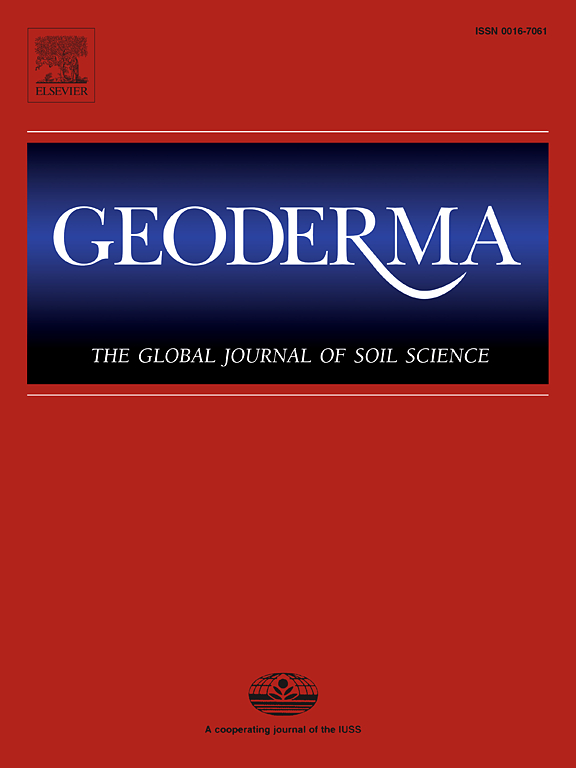Vulnerability of soil organic carbon in artificially constructed urban green spaces: Linking soil organic carbon physical fractions, microbial dynamics, and soil properties
IF 6.6
1区 农林科学
Q1 SOIL SCIENCE
引用次数: 0
Abstract
Soils in urban green spaces are often artificially constructed and highly disturbed, yet their capacity for long-term carbon (C) sequestration remains underexplored. This study evaluates soil organic C (SOC) content and vulnerability in three types of urban green spaces, tree-only roadside greenery, belt-type roadside greenery, and urban parks, with a natural grasslands serving as a reference. We analyzed SOC physical fractions and microbial activity under varying soil structural and chemical conditions, using the SOC vulnerability index (SOCVI), defined as the ratio of labile to stable fractions, to assess SOC stability. Results show that urban parks and tree-only roadside greenery have 87% lower SOC content than grasslands on average, and they contain a disproportionately high fraction of labile C, which increases SOC vulnerability. Tree-only roadside greenery exhibited particularly high SOCVI primarily because, despite low overall C inputs, its microbial activity relative to SOC is high, leading to inefficient stabilization of SOC as stable fractions. This condition is further exacerbated by alkaline pH and compaction, which hinder effective C sequestration. Although belt-type roadside greenery achieved higher SOC content through additional C inputs from understory vegetation and slightly improved soil structure, its SOCVI remained high, indicating that increased C inputs alone does not ensure stabilization. Structural equation modeling identified that mean annual temperature (MAT), soil pH and glomalin-related soil protein (GRSP) as key regulators of SOCVI. These findings underscore that enhancing SOC sequestration in urban green spaces requires integrated management strategies that optimize soil pH, improve structural properties, and support beneficial microbial activity alongside increased C inputs.
人工建设城市绿地土壤有机碳脆弱性:土壤有机碳物理组分、微生物动态和土壤性质的联系
城市绿地中的土壤通常是人工建造的,受到高度干扰,但其长期碳(C)固存能力仍未得到充分开发。本研究以天然草地为参照,对纯树木路边绿地、带状路边绿地和城市公园3种类型的城市绿地土壤有机碳(SOC)含量和脆弱性进行了评价。利用土壤有机碳脆弱性指数(SOCVI)(即不稳定组分与稳定组分的比值)对不同结构和化学条件下土壤有机碳物理组分和微生物活性进行了分析。结果表明,城市公园和路边绿化带土壤有机碳含量比草地低87%,且不稳定碳含量过高,增加了土壤有机碳脆弱性。只有树木的路边绿地表现出特别高的SOCVI,主要是因为尽管总碳输入较低,但其相对于SOC的微生物活性较高,导致SOC作为稳定组分的稳定效率较低。碱性pH和压实会进一步加剧这种情况,从而阻碍有效的碳固存。虽然通过增加林下植被的碳输入和略微改善土壤结构,带状路边绿化获得了更高的有机碳含量,但其SOCVI仍然很高,表明仅增加碳输入并不能保证稳定。结构方程模型分析发现,年平均温度(MAT)、土壤pH和glomalin相关土壤蛋白(GRSP)是SOCVI的关键调控因子。这些研究结果表明,提高城市绿地有机碳的吸收需要综合管理策略,优化土壤pH值,改善结构特性,支持有益微生物活动,同时增加碳输入。
本文章由计算机程序翻译,如有差异,请以英文原文为准。
求助全文
约1分钟内获得全文
求助全文
来源期刊

Geoderma
农林科学-土壤科学
CiteScore
11.80
自引率
6.60%
发文量
597
审稿时长
58 days
期刊介绍:
Geoderma - the global journal of soil science - welcomes authors, readers and soil research from all parts of the world, encourages worldwide soil studies, and embraces all aspects of soil science and its associated pedagogy. The journal particularly welcomes interdisciplinary work focusing on dynamic soil processes and functions across space and time.
 求助内容:
求助内容: 应助结果提醒方式:
应助结果提醒方式:


